A discussion the other night on social media has my mind wrought up in the mess of oscillation damping in tree crowns. Branches, both primary and secondary, play an important role in damping, or decreasing the amplitude of movement, of tree parts when in motion. My comment that started this thinking was initially on decay presence in large stems, and how that may affect damping the movement of the stem or limb. If the heartwood, which plays a role as static mass, is removed from the process of decay, the limb is more susceptible to failure, or at least more susceptible to strain, in the form of cracking or failure. By adding structural support systems, trees become even more like musical systems. Tree support systems directly provide another linear coupling to the damping process, and also provide another mode of frequency tuning in which the tree can utilize for it’s mechanics. Therefore, when decay has compensated one form of natural support in the case of heartwood acting as a foundation of static mass, we can actually re-tune the tree with supplemental support systems, thus compensating for that lost avenue of frequency tuning in the form of another.
I’ve spoken in the past about Alex Shigo’s thoughts on stress and strain. Stress as a reversible condition and strain as a nonreversible condition. In this discussion, the less decay is present, the more the heartwood of a tree can lend a hand in strengthening the mechanics of a stem. The stem, then, without decay, is capable of handling greater stresses. When heartwood is decayed, that process brings with it a breakdown of the stem. Sure, the tree is putting on reaction wood, if it can, at the greatest points of stress, but this struggle to compensate is adding other stresses to the system too, aside from compensating for mechanical strength. Decay then, or loss of heartwood, can be thought of as a strain. I believe supplemental support systems can change this non-reversable state of strain.
As arborists, we can reverse certain mechanical strains on trees with well designed, researched, and installed support systems, not only in the form of linear strength (load limit), but also in the form of energy transfer.
The abstract from research by H.C. Spatz and B. Thekes from 2013 in a paper titled Oscillation damping in trees reads:
“Oscillation damping is of vital importance for trees to withstand strong gusty winds. Tree adaptation to wind loading takes place over a long time and during a storm only passive damping mechanisms can reduce the impact of the wind on trunk and roots. Structural damping, a phenomenon, which is associated with the conspicuous movements of the branches relative to the trunk is of particular importance. Primary and higher order branches can be seen as multiple tuned mass dampers. Moreover, as the frequency bands overlap within branches and between primary branches and the entire tree, resonance energy transfer can distribute mechanical energy over the entire tree, such that it is dissipated more effectively than in a tree with stiff branches and not so much focused on the tree trunk and the roots. Theoretical studies using modal analysis and finite element methods have supported these assertions. Next to “multiple mass damping” and “multiple resonance damping”, both characterized by linear coupling between the elements, a third non linear mode, operative at large amplitudes has been identified: “damping by branching”. In all these not mutually exclusive concepts frequency tuning between the elements appears to be a fundamental requisite.” (Spatz, Thekes)
I am fascinated by this concept from the abstract: Moreover, as the frequency bands overlap within branches and between primary branches and the entire tree, resonance energy transfer can distribute mechanical energy over the entire tree, such that it is dissipated more effectively than in a tree with stiff branches and not so much focused on the tree trunk and roots.
So then it is absolutely possible that cable systems installed in the crowns of trees can act as vectors to better distribute that energy resonance. Tree support systems provide linear thresholds of how far tree limbs can move, though, so does this offset the energy transfer as well? Does this offset the damping effect? Back to the concept of decay presence, because to answer this current question, we need to establish goals in any specific project. Let’s assume, because that’s all I’m doing, that at some level, cable systems can contribute to the overall damping efficiency of the tree. The linear movement thresholds that a cabling system provides, can definitely be a large asset when the presence of heartwood in a stem of large branch is lacking, or is in a state of decay. Remember, without static mass, which is a strain itself, any form of further mechanical strain can directly lead to whole failure or active failure.
So then, with the addition of supplemental support systems, we potentially have two things more to offer a tree crown besides linear strength and lever force reduction, and those are: better oscillation damping in the form of another avenue of energy transfer, and also a synthetic motion stop, in a sense, that can play a major role in strength when the static mass of a stem has been compensated and any further strain could potentially cause whole tree failure.
Many thanks to the inspiration for this post to Shigo, Spatz, Thekes (literary references), Meilleur and Jacobs (Facebook conversation).
Disclaimer: I am not by any means an expert in tree biomechanics, but I did stay at a Holiday Inn Express last night.





Leave a Reply
Your email is safe with us.